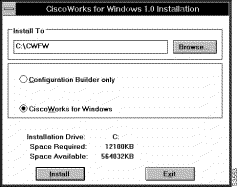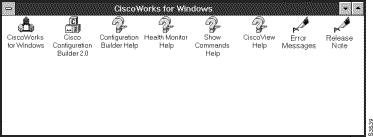|
|

This chapter provides the following sections:
This section provides CiscoWorks for Windows software and hardware requirements.
You must install the following software in order to run CiscoWorks for Windows:
The minimum hardware requirements for running CiscoWorks for Windows include the following:
CiscoWorks for Windows 1.0 applications are supported for specific Cisco Internetwork Operating System (Cisco IOS) versions and Cisco devices.
CiscoWorks for Windows 1.0 applications are supported for Cisco IOS versions as follows:
Configuration Builder, Health Monitor, and Show Commands applications are supported on these Cisco devices:
CiscoView is supported on these Cisco devices:
You can install Configuration Builder only or the complete suite of CiscoWorks for Windows applications (Configuration Builder, Show Commands, Health Monitor, and CiscoView).
You need to complete the following tasks to install CiscoWorks for Windows:
1. If you are upgrading from Configuration Builder 1.1 to 2.0, back up your data files as described in the section "Upgrading from Configuration Builder 1.1 to 2.0."
2. Install CiscoWorks for Windows applications as described in the section "Installing Applications."
3. If you are using the entire suite of CiscoWorks applications, you must load a set of Management Information Base (MIB) files into HP OpenView's database. See the section "Loading MIBs into HP OpenView's SNMP MIB Database."
4. Discover your network in order to identify Cisco devices and start CiscoWorks for Windows. See the section "Starting CiscoWorks for Windows."
If you are upgrading from Configuration Builder 1.1 to Configuration Builder 2.0, back up all Configuration Builder 1.1 data files before beginning the installation procedure. Remove the existing ciscocb.ini file from your PC before you install Configuration Builder 2.0. For a list of data file types, see the section "Configuration Builder Files" in Chapter 2, "CiscoWorks for Windows Features."
If you are installing the complete suite of CiscoWorks for Windows applications, ensure that both HP OpenView and a WINSOCK-compliant TCP/IP stack are already installed on your hard drive before completing the steps in this section.
As a safety precaution, make a backup copy of the CiscoWorks for Windows master diskettes. Then use the copies to install CiscoWorks for Windows and store the original diskettes.
To install CiscoWorks for Windows applications, complete the following steps:
Step 1 If you are installing the complete suite of CiscoWorks for Windows applications, (not Configuration Builder only), insert the HP OpenView patch diskette into your a:\ or b:\ drive. In the MS Windows Program Manager window, select Run from the File menu. Enter a:\setup or b:\setup and follow the system prompts to complete installation of the HP OpenView patch.
Step 2 Insert the first CiscoWorks for Windows 1.0 diskette into your a:\ or b:\ drive.
Step 3 In the MS Windows Program Manager window, select Run from the File menu. Enter a:\setup or b:\setup.
You are prompted to install Configuration Builder only or the complete suite of CiscoWorks for Windows applications (Configuration Builder, Show Commands, Health Monitor, and CiscoView). See Figure 1-1.

Step 4 Choose the application(s) you want to install. To accept the default directory, simply select the Install button. Or, to specify a new directory, select the Browse button and specify a new directory. Then select the Install button.
The installation program lists the files currently being installed and then prompts you to insert the remaining diskettes in sequential order.
Step 5 Install the remaining diskettes.
You are prompted to restart your system now or later.
Step 6 Specify either the restart now or the restart later option.
Step 7 If you have chosen to restart later, you are prompted to review the README file. Select Yes to learn about CiscoWorks for Windows 1.0 software release information. Select No to bypass this file.
You now have a CiscoWorks for Windows program group in your Program Manager window. See Figure 1-2.

Step 8 If you have upgraded from Configuration Builder 1.1 to 2.0 and want to access your existing data files from Configuration Builder 2.0, make sure to copy the files you backed up into the \data subdirectory within the directory where you installed Configuration Builder 2.0.
A set of Management Information Base (MIB) files must first be loaded into the HP OpenView Simple Network Management Protocol (SNMP) MIB database so that the CiscoView and Health Monitor applications can query devices for information. The MIB files must be loaded in the following sequence: cisco10.mib, rfc1213.mib, rfc1285.mib, and rfc1516.mib.
The cisco10.mib allows HP OpenView to poll for Cisco-specific MIB variables. The rfc1213.mib file provides the Internet standard MIB II for use with network management protocols in TPC/IP-based internets. The rfc1285.mib file is used to manage devices with Fiber Distributed Data Interface (FDDI) cards. The rfc1516.mib is used to manage Cisco 2500 series devices with repeater ports.
To load the MIBs into HP OpenView's SNMP MIB database, start HP OpenView and complete the following steps:
Step 1 Select Control>SNMP Manager>Manage Database to open the SNMP Manager window.
Step 2 In the SNMP Manager window, press the Select button to open the Add File window.
Step 3 In the Add File window, select c:\ov\mibs\mib filename. Click OK to add the MIB file to the Select list in SNMP Manager window.
Repeat steps 2 and 3 for each MIB file. (Remember to add the MIB files in the following sequence: cisco10.mib, rfc1213.mib, rfc1285.mib, and rfc1516.mib.)
Step 4 In the SNMP Manager window, select the Add button to add the MIB files to the HP OpenView database.
The SNMP Manager will indicate when the files are successfully added to the database.
If you choose to reinstall CiscoWorks for Windows, the program will update older versions of existing CiscoWorks for Windows 1.0 files. If you choose to deinstall the application, all files associated with CiscoWorks for Windows 1.0 are deleted, and the CiscoWorks for Windows 1.0 program group is removed from the Program Manager window.
 | Caution When you select the reinstall or deinstall option, the program will remove the entire \data subdirectory in the directory where you installed Configuration Builder 2.0. Make sure to back up your \data subdirectory files to a new location before you reinstall or deinstall CiscoWorks for Windows. |
To reinstall or deinstall CiscoWorks for Windows, complete these steps:
Step 1 Insert the first CiscoWorks for Windows diskette into your a:\ or b:\ drive.
Step 2 In the MS Windows Program Manager window, select Run from the File menu. Enter a:\setup or b:\setup.
You are prompted to reinstall or deinstall CiscoWorks for Windows.
Step 3 Select the preferred option.
The CiscoWorks for Windows installation program appends Health Monitor and Show Commands items to the HP OpenView Monitor menu. Configuration Builder and CiscoView items are appended to the HP OpenView Control menu. CiscoWorks for Windows help items are appended to the HP OpenView Help menu. See Figure 1-3.

In order to run CiscoWorks for Windows applications, complete the following tasks:
Step 1 Use the HP OpenView Autodiscovery menu options to discover your network and create a network map. Even if you already have a network map, you must discover it again in order for Cisco devices to be identified within the map.
See your HP OpenView for Windows user guide for details on using the HP OpenView Autodiscovery features.
Step 2 Start any application by selecting a Cisco device in your HP OpenView map, and then selecting a CiscoWorks application menu item. (You can also start CiscoView by double-clicking on a Cisco device within the network map.)
![]()
![]()
![]()
![]()
![]()
![]()
![]()
![]()
Posted: Fri Sep 27 13:07:42 PDT 2002
All contents are Copyright © 1992--2002 Cisco Systems, Inc. All rights reserved.
Important Notices and Privacy Statement.